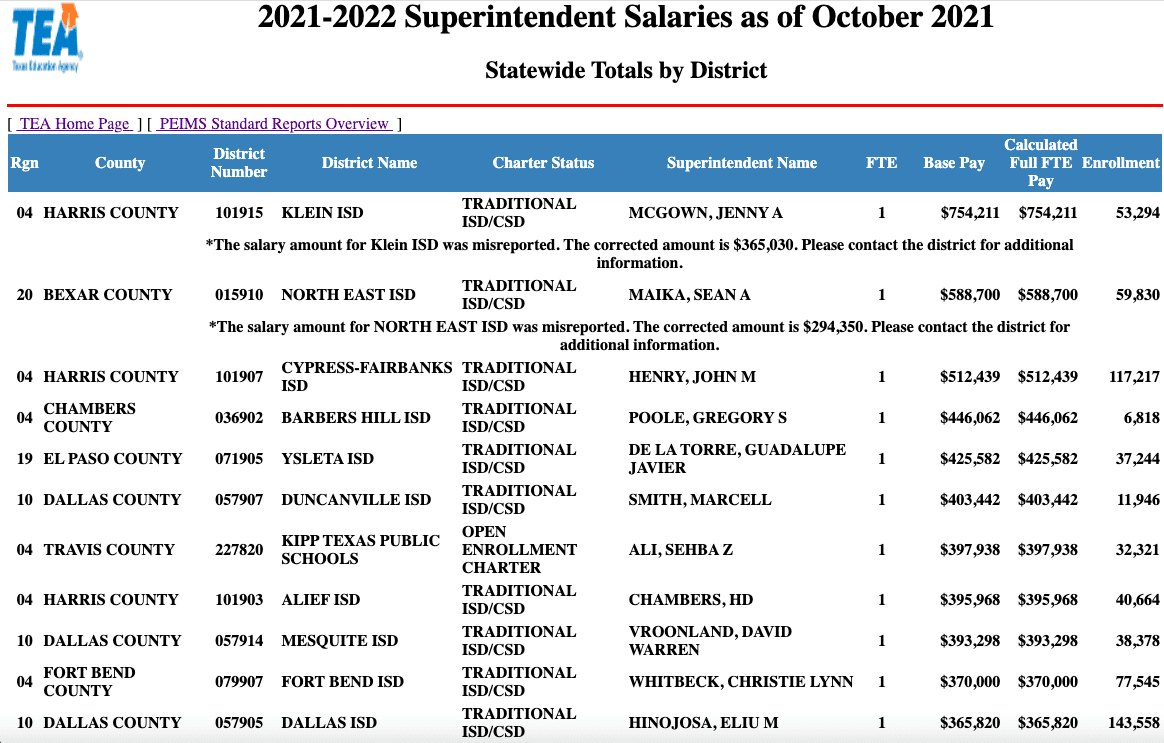UPDATED April 12, 2022 to show a correction made by TEA regarding Klein ISD data.
CORRECTED April 13, 2022 to show David Hicks moving to Northwest ISD, not North East ISD.
Dozens of Texas public school superintendents are taking home super-size salaries, according to newly released data from the Texas Education Agency.
The TEA report shows six school districts’ top administrators are receiving more than $400,000 in base pay for the 2021-22 school year. (The top two listings appear to include more than a single year’s pay, compared to the superintendents’ salaries for the previous year; TEA has added corrected data misreported by Klein ISD.)
Another 55 superintendents are paid at least $300,000.
“What is there to justify these exorbitant salaries?” asked James Quintero, a policy director for free-market think tank Texas Public Policy Foundation. “Public school enrollment is on the decline statewide, student outcomes are abysmal, and taxpayers are struggling to get by. If anything, superintendent pay should be trending down to better match realities on the ground.”
The lucrative salaries are supplemented by benefits like insurance; pension contributions; and allowances for cars, phones, and housing. They often include hefty retention bonuses as well.
All are provided at taxpayers’ expense.
“From the average Texan’s eyes, it is shocking to know that people who are deemed ‘public servants’ working for our government are in the top tax bracket, while millions of middle-class Texans are being crushed under the weight of property taxes that fund their salaries,” Texans for Fiscal Responsibility President Tim Hardin told Texas Scorecard.
Many elected school board members, who are responsible for hiring superintendents, say they must offer generous compensation packages in order to compete with other districts and the private sector, and to attract the best people.
But are they attracting the “best” people?
In 2018, Grand Prairie ISD board member Terry Brooks said their then-superintendent was “worth every penny we pay her and more.”
District taxpayers were paying her $405,000 (the second-highest superintendent salary in the state), plus tens of thousands more in perks like travel and housing allowances, and annual “retention supplements” as high as $150,000—five times the district’s median income of $30,000.
Yet she was caught spending another $160,000 in taxpayer money on home remodeling expenses that were never approved by the board. She also failed to notice that her chief financial officer had embezzled $600,000 in cash from the district.
Last year, Round Rock ISD board members hired Superintendent Hafedh Azaiez at a salary of $350,000—almost $50,000 more than the district’s previous superintendent. Yet he spent months on (paid) administrative leave while authorities investigated a scandal involving domestic assault allegations from Azaiez’s girlfriend.
These examples may represent “a few bad apples,” but they’re expensive apples.
In 2021, TEA reported more than 60 superintendents were receiving a base pay in excess of $300,000, with two taking home more than $400,000.
The numbers released Friday are as of October 2021.
Since then, 10 superintendents in North Texas alone have stepped down or announced their departures—most recently, Sherman ISD Superintendent David Hicks.
Some are simply retiring, while others are moving on to new opportunities. Hicks, whose current base pay is $270,000, has been tapped to be the new superintendent of Northwest ISD.
Many, like Fort Worth ISD Superintendent Kent Scribner, will walk away with substantial payouts.
None are leaving because their pay is too low.
“Superintendent salaries are proof that ISDs don’t have a revenue problem, they have a spending problem,” said Quintero.
“Our school administrators need some accountability, and our public schools need to learn some fiscal responsibility,” Hardin added.






